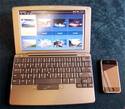Slim Linux laptop has potential
Jul 13, 2007 — by LinuxDevices Staff — from the LinuxDevices Archive — views Palm's Linux-powered Foleo has potential, but only if Palm can stop denying that the device is actually laptop, reckons Sascha Segan of Gearlog. Palm has positioned the Foleo as a “mobile companion” for itinerant workers needing only email, document prep, and PowerPoint capabilities.
Palm's Linux-powered Foleo has potential, but only if Palm can stop denying that the device is actually laptop, reckons Sascha Segan of Gearlog. Palm has positioned the Foleo as a “mobile companion” for itinerant workers needing only email, document prep, and PowerPoint capabilities.
The Foleo has been pitched as a “revolutionary product category” ever since Palm began hiring Linux developers more than a year ago. When Palm unveiled the device last month, it breathlessly billed the Foleo as the first of a “new class” of products likely to go down in history as Palm's best-selling ever — more popular than the Treo smartphone, and more popular than the original “Palm Pilot.”
When allowed a few minutes with the Foleo at a regional trade show, Segan discovered that the Foleo is really a laptop afterall, albeit one with an appliance-like Linux-based OS. In a brief “hands on” mini-review, he writes:
The Foleo has a bit of heft at just over 2 pounds, but it didn't feel all that heavy – it definitely would have taken a weight off my back if it replaced my IBM Thinkpad T40. The customized, Linux-based interface is very simple and very responsive. There's actually no application launcher or “home screen,” just an application menu that you pop down by using a dedicated “Apps” key; you navigate around using a little eraser-head-like touchpoint device in the middle of the keyboard. Click near the top of the screen, and application menus appear. It's all the laptop experience you like, with none of the annoying slowdowns you hate. If Palm plays their cards right, yes, they could replace laptops in a lot of situations.

Palm Foleo compared to Palm Treo
(Click image for Foleo details)
Your LinuxDevices reporter, meanwhile, also had a chance to lay paws on a Foleo, during a recent dinner with a Palm developer. Although not allowed to pull up a shell on the device and have a real look around, we learned:
- Battery life “according to Q/A, not marketing,” under constant use with WiFi on and the screen set to the default (65 percent) brightness is an honest five hours.
- It has a real bash shell, because bash's built-ins reduce process loading (forking) at boot time, for faster start-up.
- The magnetically latched case is grippy rubber with undulations — very easy to carry.
- The keyboard conforms to the smaller ISO standard, with 18mm pitch.
- All apps run all the time, and only run maximized to full-screen. Switching between them (via a hardware key) is instantaneous.
- Optional “phone in range” authentication accepts the presence of user's phone within Bluetooth range as the password.
- The Opera browser looks pretty good on the 10.2-inch, 1024 x 600 display (external VGA resolution is normal XGA (1024 x 768)
- Fonts (on the prototype we saw) were okay, but could do with some sub-pixel rendering and something like Red Hat's outstanding (and free) Liberation fonts
- Video out (for PowerPoints) is mini-VGA — don't lose that dongle.
Additional observations can be found in Segan's GearLog story, here.
This article was originally published on LinuxDevices.com and has been donated to the open source community by QuinStreet Inc. Please visit LinuxToday.com for up-to-date news and articles about Linux and open source.